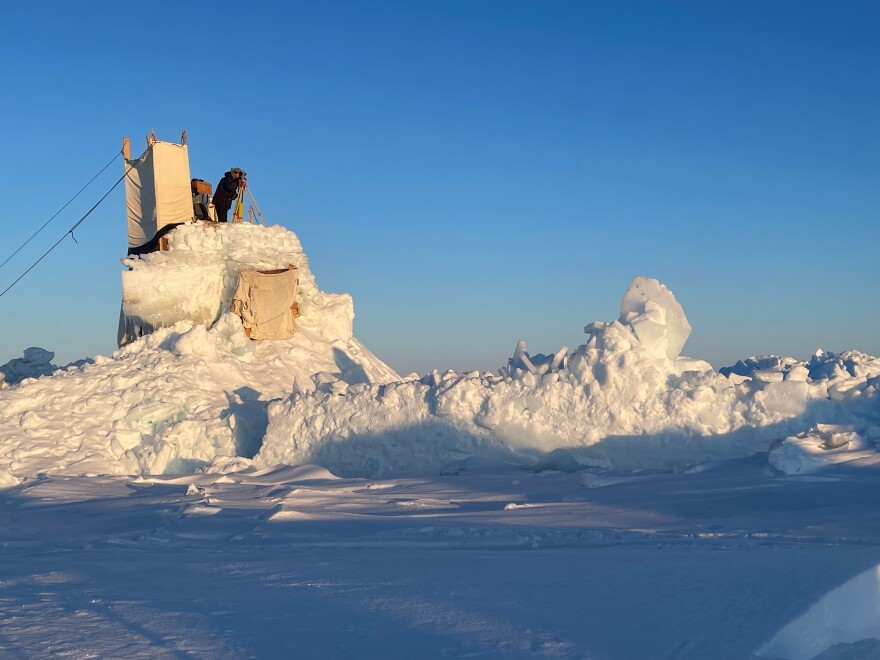When bowhead whales pass Utqiagvik on their way north, it’s a good time to count them. So ever since April 1, observers have been climbing a perch built on sea ice, right at the edge of an open lead, to count the whales as they swim past.
Every 10 years, scientists and local hunters team up to carry out this census of bowhead whales that migrate between Bering, Chukchi and Beaufort seas. It is an effort to evaluate the health of the whale population up north, and it helps set subsistence harvest limits for the years to come.
“We do it for the whaling captains, and we do it in collaboration with them,” said John Citta, a senior wildlife biologist with the North Slope Borough Department of Wildlife Management who is leading the effort. “They've taught us how to be on the ice safely.”
Bowheads might be thriving as ice declines
Whaling captains trained the observers on how to work safely on the ice. They will continue counting whales from the perch throughout the spring bowhead migration.
That visual count is only the first step of the census. Scientists will need to statistically adjust the data to account for the whales the observers don’t see. But so far, Citta said the raw numbers have been high. He said the final abundance estimate might turn out at around 20,000 whales or more. The highest counts in recent years found around 17,000 whales.
“We think there are a lot more whales out there now than what there used to be,” he said. “We suspect the population has continued to grow, but we just don't know that for certain yet.”

Citta said the bowheads might be thriving as the sea ice in the Arctic declines. Past bowhead research suggests that the whales were in better physical condition in years with less sea ice, he said.
But the shrinking sea ice and increasing open water habitat can also lead to more competition with humpbacks, predation from killer whales or collisions with ships. Citta said the only way to know is to continue monitoring the bowhead population.
Hunters’ contribution to whale count
Whalers have been involved in the bowhead census since the early 70s. That’s when the International Whaling Commission, an organization that regulates whaling, estimated that there were fewer than a thousand whales in the Bering-Chukchi-Beaufort stock. That estimate was so low that the commission first tried to place a moratorium on whaling and then reduced the harvest.
Hunters protested the limit, saying it was based on an undercount.
While that early count only included whales passing through the open lead, hunters knew that some animals traveled far from shore or under thick ice. Over the years, the late Craig George collaborated with local whalers to improve the census methods and account for those whales.
“We were able to improve our techniques over the years,” said Geoff Carroll, a retired wildlife biologist who worked with George. “We were able to show that there's plenty of bowheads to support the subsistence hunt.”

An acoustic component of the count, pioneered around 1984, helped determine how many whales could be heard migrating when the lead is closed or the weather is too poor to see whales. Kate Stafford, a researcher at the Marine Mammal Institute at Oregon State University who studies bowheads using acoustic monitoring, has worked on the past five bowhead censuses.
“This combination of methods makes for a more robust population estimate and confirms what Native whalers have always known – that whales migrate in heavy ice, sometimes far offshore and at all times of the day,” Stafford said.
Declining sea ice could change the census
Last August, scientists deployed hydrophones – underwater devices that record ocean sounds – on the sea floor. They plan to retrieve them this fall.
“It turns out that bowhead whales really talk a lot when they're migrating,” said Carroll, who is also an advisor for this year’s census.
An aerial survey will happen later this summer.
The North Slope Borough is collaborating with the National Oceanic and Atmospheric Administration on flights over the Alaskan and Canadian Beaufort seas to photograph migrating whales, Citta said.
While counting whales from the observation perch has been a success this season, Citta said that with sea ice becoming less reliable each year, the method is getting more dangerous.
“We're worried that those ice-based counts will not be a viable way to count bowheads in the future,” he said. “If that's the case, we need alternatives, and one of the leading alternatives is an aerial survey.”
After the count is done, scientists will need to process the data, which can take up to two years. The International Whaling Commission expects the final estimate, which will be used to decide whether to renew the region’s subsistence whaling quota, in 2029.


